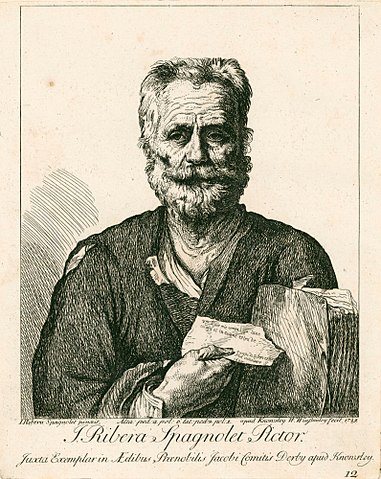
Born: 12 January 1591, Naples
Died: 2 September 1652 (aged 61)
Period: Baroque
The Life of Jusepe de Ribera
Jusepe de Ribera, also known as José de Ribera or by his Italian name, Giuseppe Ribera, was a Spanish painter and printmaker, notable for his significant contribution to the Baroque period. Born on January 12, 1591, in Játiva, near Valencia, Spain, Ribera spent most of his career in Italy, where he became a leading figure of the Neapolitan school of painting.
Ribera’s early life in Spain is not well documented, but it is known that he moved to Italy in his late teens or early twenties, initially studying and working in Rome. In Rome, he was influenced by the works of Caravaggio, adopting the use of dramatic light and shadow, and focusing on realism and the physical and emotional intensity of his subjects.
By 1616, Ribera had settled in Naples, which was then under Spanish rule. Naples became the primary base for his career, and he rarely left the city thereafter. In Naples, Ribera achieved great success and became a leading painter, receiving commissions from the local nobility as well as from the Spanish viceroys. His work was characterized by a dramatic use of light, rich detail, and a focus on religious and mythological subjects, often portraying saints and martyrs in moments of intense emotion or suffering.
Ribera’s influence extended beyond Naples, affecting the development of Baroque painting across Italy and Spain. Despite his reputation for depicting violence and the macabre, Ribera’s portfolio is diverse, including not only religious and mythological scenes but also portraits and genre scenes. His works are distinguished by their realism, psychological depth, and technical mastery.
Ribera was also an accomplished printmaker, and his etchings contributed significantly to his reputation. These works often reflected the themes of his paintings but allowed him to reach a wider audience.
Despite his success, details about Ribera’s personal life are relatively sparse. He married Caterina Azzolino, the daughter of a Sicilian painter, with whom he had several children. Ribera’s legacy as an artist is significant, with his works held in high esteem and featured in major museums and collections worldwide.
Jusepe de Ribera passed away on September 2, 1652, in Naples. His contribution to the Baroque movement and his influence on the Neapolitan school of painting have cemented his status as one of the most important artists of the 17th century.
Jusepe de Ribera’s Notable Works
Jusepe de Ribera, also known as José de Ribera or by his Italianized name Giuseppe Ribera, was a Spanish Tenebrist painter and printmaker, noted for his dramatic use of light and shadow. Born on January 12, 1591, in Játiva, near Valencia, Spain, he spent most of his career in Italy, where he became a leading figure of the Neapolitan school. Ribera is celebrated for his intensely realistic depictions of religious subjects, mythological scenes, and portraits, characterized by their emotional depth and often stark realism. Here are ten of his most famous works, reflecting his mastery over chiaroscuro and his profound influence on the Baroque period:
- “The Clubfooted Boy” (1642) – A compassionate portrait of a boy with a clubfoot, showcasing Ribera’s skill in rendering human emotion and physical detail.
- “Martyrdom of Saint Philip” (1639) – A dramatic representation of the crucifixion of Saint Philip, highlighting Ribera’s ability to convey intense emotion and physical suffering.
- “Saint Jerome and the Angel of Judgment” (1626) – This work depicts Saint Jerome, a common subject for Ribera, in a moment of divine encounter, notable for its detailed realism and emotional intensity.
- “The Drunken Silenus” (1626) – A depiction of the mythological figure Silenus, showcasing Ribera’s talent in portraying mythological themes with a sense of realism and humanity.
- “Magdalena Ventura with Her Husband and Son” (1631) – This portrait of a bearded woman, Magdalena Ventura, is remarkable for its sensitive portrayal of a unique subject, highlighting societal themes of gender and identity.
- “Saint Bartholomew” (1634) – Ribera frequently depicted Saint Bartholomew, often focusing on the saint’s martyrdom with a dramatic and realistic portrayal of suffering.
- “The Lamentation Over the Dead Christ” (1622) – A powerful depiction of grief, showing the dead Christ surrounded by mourning figures, demonstrating Ribera’s skill in capturing human emotion.
- “Apollo and Marsyas” (1637) – This painting illustrates the myth of Apollo flaying Marsyas, a theme that allowed Ribera to explore human anatomy and emotion in detail.
- “Jacob’s Dream” (1639) – Depicting the biblical story of Jacob dreaming of a ladder reaching to heaven, this work showcases Ribera’s mastery of light and shadow to create a mystical atmosphere.
- “Saint Mary of Egypt” (1641) – A representation of the penitent saint, notable for its detailed portrayal of age and repentance, emphasizing Ribera’s skill in depicting the textures of skin and fabric.
Ribera’s influence extended across Europe, impacting not only his contemporaries in Italy and Spain but also future generations of artists. His works are celebrated for their technical skill, emotional depth, and the artist’s unflinching approach to realism and human suffering. Ribera remains a significant figure in the Baroque period, renowned for his contributions to the development of painting in the 17th century.